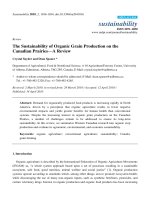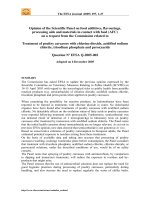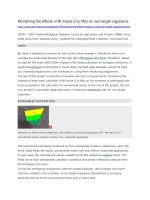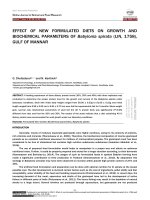Bio-efficacy of seed protectant chemicals for management of Angoumois grain moth on paddy
Bạn đang xem bản rút gọn của tài liệu. Xem và tải ngay bản đầy đủ của tài liệu tại đây (223.78 KB, 8 trang )
Int.J.Curr.Microbiol.App.Sci (2019) 8(10): 626-633
International Journal of Current Microbiology and Applied Sciences
ISSN: 2319-7706 Volume 8 Number 10 (2019)
Journal homepage:
Original Research Article
/>
Bio-efficacy of Seed Protectant Chemicals for Management of Angoumois
Grain Moth on Paddy
Basavanjali1*, Sushila Nadagouda1, A. Prabhuraj1, Shivaleela1 and Basavegowda2
1
Department of Agricultural Entomology, College of Agriculture, Raichur, India
2
Seed Unit, University of Agricultural Sciences, Raichur, 584104, India
*Corresponding author
ABSTRACT
Keywords
Spinosad,
Emamectin
benzoate, Seed
damage, Paddy and
angoumois grain
moth
Article Info
Accepted:
07 September 2019
Available Online:
10 October 2019
Studies on the bio-efficacy of seed protectant chemicals against angoumois
grain moth on paddy was carried out in the Seed unit UAS, Raichur during
2018-19 with ambient conditions (20.3 ± 2.3 oC temperature and 50.5 ± 6.3
% RH). The observations were recorded on seed damage, seed weight loss
and live adults up to 180 DAT. Up to ninety days after treatment imposition
no seed damage, no seed weight loss and no live adults was noticed in any
of the treatments. The treatments of spinosad 45 SC @ 4.4 mg kg-1 and
emamectin benzoate 5 SG @ 40 mg kg-1 recorded least seed damage, least
seed weight loss and suppression of adult population at one hundred and
eighty days of treatment imposition and both differed significantly from
remaining treatments.
Introduction
Rice is a vital food to more than half of the
world’s population. Rice accounts for 55 per
cent of total cereal production in the country.
In India rice is grown over 42.9 million ha,
with production of 111.1 MT and productivity
of 2580 kg per ha (Anon., 2018). Rice
provides instant energy as its most important
component is carbohydrate (starch) and fat
content or lipids (1 %) and due to this reason it
is considered as a complete food. After
harvesting, unprocessed paddy is stored for
varied periods of time depending on market
demand, size of production and the farmer's
needs. Storage is the most important and
critical postharvest operation.
Generally lepidopterans and coleopterans
cause maximum damage in storage (Usman,
1957). In India the annual storage losses were
estimated as 14 million tonnes of food grains
worth $16,000 million every year.
Out of this, food grain losses due to insects
alone account for a monetary loss of $ 300
626
Int.J.Curr.Microbiol.App.Sci (2019) 8(10): 626-633
million (Mohan and Kavitharaghavan, 2008).
During storage, paddy is highly vulnerable to
infestation by a variety of insect pests and
diseases.
Among them, the Angoumois grain moth,
Sitotroga cerealella (Olivier) was the most
destructive internal pests of paddy and it is
carried over from field to the storehouses
through the field infested grains.
Therefore, there is an urgent need to identify
insecticides that can effectively prevent the
storage losses, easily available, affordable,
safer and least detrimental to the environment.
Many of these insecticides are effective at
relatively low dosage and provide long term
protection, which can range from six to twelve
months (Athanassiou, 2004). In the countries
where storage facilities are inadequate,
insecticides are one of the most effective
weapons for disinfesting and protecting stored
products from infestation.
Materials and Methods
Studies on the bio-efficacy of seed protectant
chemicals like emamectin benzoate 5 SG @
40 mg kg-1, spinosad 45 SC @ 4.4 mg kg-1,
deltamethrin 2.8 EC @ 0.04 ml kg-1,
chlorfenapyr 10 EC @ 0.02 ml kg-1, acorus
TNAU formulation @ 10 g kg-1 and sweet flag
rhizome powder @ 20 g kg-1 against
angoumois grain moth on paddy was carried
out in the Seed unit UAS, Raichur during
2018-19 with ambient conditions (20.3 ± 2.3
o
C temperature and 50.5 ± 6.3 % RH).
were procured from Seed unit with high
percentage of germination (97.00 %) and low
moisture content (10.49 %) was taken for each
treatment. Recommended quantities of
insecticides were diluted in ten ml of water
and 10 per cent sticky material (gum acacia)
was added to treat two kg of seed for proper
coating. Similarly, control was maintained
without any treatment for comparison.
After treatment, seeds were dried in shade and
packed in two kg capacity non woven bag and
kept for storage under ambient condition for a
period of six months. Later ten pairs of adults
were released into each non woven bag.
Observations were made on per cent seed
damage, seed weight loss and the number of
live adults in representative sample.
Seed damage (%)
Seeds were thoroughly mixed and one
hundred seeds were randomly drawn from
each treatment and replications, seeds with
exit holes were considered as damaged seeds
and expressed as per cent seed damage.
Seed weight loss
It was computed by following formula as
suggested by Harris and Limbald (1978).
Bioefficacy studies on angoumois grain
moth
The experiment was conducted in completely
randomized design (CRD) with seven
treatments and three replications. Two kg of
freshly harvested paddy (Gangavati sona)
Where;
O.W = Original weight on dry weight basis
C.W = Current weight on dry weight basis
627
Int.J.Curr.Microbiol.App.Sci (2019) 8(10): 626-633
Number of live adult insects per 100 g seeds
Number of live adult insects emerged from
100 g sample seed of each replication of the
treatment was counted.
Results and Discussion
Seed damage
No seed damage was recorded in all the
treatments at ninety days after treatment. After
one hundred and eighty days of treatment the
spinosad 45 SC (0.33 %) and emamectin
benzoate 5 SG (0.67 %) recorded lowest seed
damage and were found to be the most
superior in reducing the insect damage among
all other treatments and were on par with each
other.
Highest (18.67 %) per cent seed damage was
recorded in untreated control and was inferior
to all the other treatments. The order of
efficacy of different seed protectant chemicals
was as follows spinosad 45 SC = emamectin
benzoate 5 SG > acorus TNAU formulation >
deltamethrin 2.8 EC > sweet flag rhizome
powder > chlorfenapyr 10 EC (Table 1).
Table.1 Effect of seed protectant chemicals on seed damage of paddy seed by S. cerealella
Treatments
T1 - Emamectin
benzoate 5 SG
T2 -Spinosad 45
SC
T3 Deltamethrin
2.8EC
T4 Chlorfenapyr 10
EC
T5 -Acorus
TNAU
formulation
T6 -Sweet flag
rhizome powder
T7 –Untreated
control
S. Em ±
CD@ 1%
Dosage/
kg seed
40 mg
4.4 mg
0.04 ml
0.02 ml
10 g
20 g
-
Seed damage (%)
30 DAT 60 DAT 90 DAT
0.00
(0.57)a
0.00
(0.57)a
0.00
(0.57)a
0.00
(0.57)a
0.00
(0.57)a
0.00
(0.57)a
0.00
(0.57)a
0.00
(0.57)a
0.00
(0.57)a
120
DAT
0.00
(0.57)a
0.00
(0.57)a
0.67
(3.83)a
0.00
(0.57)a
0.00
(0.57)a
0.00
(0.57)a
0.00
(0.57)a
0.00
(0.57)a
0.00
(0.57)a
1.00
(5.74)a
0.67
(3.83)a
2.33
(8.74)b
1.67
(7.33)b
3.00
(9.88)b
2.00
(8.13)b
1.05
0.00
(0.57)a
3 .67
(11.02)b
0.20
0.00
(0.57)a
5.33
(13.34)b
0.16
0.00
(0.57)a
7.33
(15.68)b
0.28
0.67
(3.83)a
11.00
(19.36)b
1.14
2.00
(8.13)b
14.33
(22.21)c
0.84
2.33
(8.74)b
18.67
(25.60)c
1.05
0.83
0.83
0.67
1.19
4.82
3.55
4.42
DAT- Days after treatment
Figures in parentheses are arcsine transformed values
Figures in the column followed by same letters are not-significant at p=0.01 by DMRT
628
150
DAT
0.33
(1.91)a
0.00
(0.57)a
2.00
(8.13)b
180
DAT
0.67
(3.83)a
0.33
(6.54)a
2.33
(8.74)b
Mean
0.17
0.05
0.83
0.72
10.05
Int.J.Curr.Microbiol.App.Sci (2019) 8(10): 626-633
Table.2 Effect of seed protectant chemicals on seed weight loss of paddy by S. cerealella
Treatments
T1 Emamectin
benzoate 5SG
T2 -Spinosad
45 SC
T3 Deltamethrin
2.8EC
T4 Chlorfenapyr
10EC
T5 -Acorus
TNAU
formulation
T6 -Sweet flag
rhizome
powder
T7 -Untreated
control
S. Em ±
CD@ 1%
Dosage/Kg
seed
Seed weight loss (%)
30
DAT
60
DAT
90
DAT
120
DAT
150
DAT
180
DAT
Mean
40 mg
0.00
(0.57)a
0.00
(0.57)a
0.00
(0.57)a
0.08
(1.57)a
0.37
(3.49)b
0.47
(3.86)b
0.15
Per cent
reduction
over
control
98.32
4.4 mg
0.00
(0.57)a
0.00
(0.57)a
0.00
(0.57)a
0.00
(0.57)a
0.00
(0.57)a
0.00
(0.57)a
0.00
(0.57)a
0.14
(2.15)ab
0.00
(0.57)a
0.71
(4.84)c
0.23
(2.77)a
1.40
(6.79)c
0.03
99.66
0.38
95.70
0.02 ml
0.00
(0.57)a
0.00
(0.57)a
0.00
(0.57)a
0.32
(3.22)b
1.45
(6.87)d
2.02
(8.18)e
0.63
92.95
10 g
0.00
(0.57)a
0.00
(0.57)a
0.00
(0.57)a
0.19
(2.48)ab
0.73
(4.90)c
1.53
(7.10)bc
0.41
95.41
20 g
0.00
(0.57)a
0.00
(0.57)a
0.00
(0.57)a
0.23
(2.72)b
0.79
(5.08)c
1.86
(7.84)cd
0.48
94.63
2.34
4.63
7.83
9.43
12.70
16.68
b
a
b
c
e
(8.81) (12.39) (16.24) (17.88) (20.87) (24.10)f
0.02
0.02
0.14
0.24
0.23
0.22
8.94
-
0.04 ml
-
0.07
0.09
0.58
1.01
0.95
DAT- Days after treatment
Figures in parentheses are arcsine transformed values
Figures in the column followed by same letters are not-significant at p=0.01 by DMRT
629
0.94
Int.J.Curr.Microbiol.App.Sci (2019) 8(10): 626-633
Table.3 Effect of seed protectant chemicals on emergence of adults of S. cerealella on paddy
Treatments
Dosage/kg
seed
No of live adults / 100 g of seeds
30
DAT
T1-Emamectin benzoate 5
SG
40 mg
T2-Spinosad 45 SC
4.4 mg
T3-Deltamethrin 2.8EC
0.04 ml
T4-Chlorfenapyr 10 EC
0.02 ml
T5-Acorus TNAU
formulation
T6-Sweet flag rhizome
powder (A. calamus)
T7-Untreated control
10 g
S. Em ±
CD@ 1%
20 g
----
60
DAT
90
DAT
120
DAT
150
DAT
180
DAT
0.00
0.00
0.00
0.00
1.00
2.00
(0.71)a (0.71)a (0.71)a (0.71)a (1.17)ab (1.56)ab
0.00
(0.71)a
0.00
(0.71)a
0.00
(0.71)a
0.00
(0.71)a
0.00
(0.71)a
7.67
(2.86)b
0.02
0.09
0.00
(0.71)a
0.00
(0.71)a
0.00
(0.71)a
0.00
(0.71)a
0.00
(0.71)a
12.67
(3.63)b
0.02
0.07
0.00
(0.71)a
0.00
(0.71)a
0.00
(0.71)a
0.00
(0.71)a
0.00
(0.71)a
18.33
(4.34)b
0.01
0.06
0.00
(0.71)a
1.33
(1.34)b
1.67
(1.46)b
1.33
(1.34)b
1.67
(1.46)b
25.67
(5.12)c
0.09
0.38
0.00
(0.71)a
1.67
(1.46)b
2.00
(1.56)b
2.33
(1.68)b
2.67
(1.77)b
29.67
(5.49)c
0.14
0.58
1.00
(1.17)a
3. 33
(2.12)b
4.67
(2.35)bc
4.00
(1.87)b
4.33
(2.20)bc
32.33
(5.73)c
0.14
0.59
DAT- Days after treatment; Figures in parentheses are √(x+ 0.5) transformed value
Figures in the column followed by same letters are not-significant at p=0.01 by DMRT
Fig.1 Effect of seed protectant chemicals on seed weight loss of paddy by S. cerealella
630
Mean
0.50
0.16
1.05
1.40
1.27
1.44
21.05
Int.J.Curr.Microbiol.App.Sci (2019) 8(10): 626-633
Fig.2 Effect of seed protectant chemicals on emergence of adults of S. cerealella on paddy
The spinosad having specific mode of action
of spinosad is to alter the function of nicotinic
and GABA-gated ion channels, causing rapid
excitation of the insect nervous system,
leading to involuntary muscle contractions,
tremors, paralysis and death of the insect takes
place and the emamectin benzoate does
stimulation of high-affinity GABA receptors
and a consequent increase in membrane
chloride ion permeability leads to dilation of
pupils, muscular in coordination, ataxia,
muscle tremors and affected insect become
paralyzed and stop feeding shortly after
exposure. Fang et al., (2002) who reported
that spinosad was effective against Sitophilus
oryzae and Tribolium castaneum on wheat
seeds. Also Rathod et al., (2018) opined that
spinosad 45 SC @ 4.4 mg per kg of seed were
found equally effective for control of pulse
beetle in pigeon pea seed after 6 months of
storage.
protection against damage by S. cerealella
resulting in without any seed weight loss.
Similarly, Ajaykumara et al., (2017) recorded
that emamectin benzoate 5 SG treated seed
was found free from the seed damage of R.
dominica after 6 months of storage.
The present findings are in conformity with
Antoine et al., (2010) who found the
effectiveness of spinosad as grain protectant in
controlling C. maculatus even after six months
of storage and Kalasagonda (1998) reported
that there was no weight loss in wheat grains
treated with sweet flag rhizome powder at 0.8
per cent concentration (Fig. 1 and Table 2).
Seed weight loss
Up to ninety days after treatment all the seed
protectant chemicals afforded complete
After one hundred and eighty days after
treatment, spinosad 45 SC recorded lowest per
cent weight loss (0.23 %) followed by
emamectin benzoate 5SG (0.47 %) treated
seeds, deltamethrin 2.8 EC (1.40 %), acorus
TNAU formulation (1.53 %), sweet flag
rhizome powder (1.86 %) and chlorfenapyr 10
EC (2.02 %) and highest (16.68 %) per cent
weight loss was recorded in untreated control
which was found to be significantly inferior to
all the treatments.
The weight loss of the grain was positively
and significantly correlated with the per cent
damage and number of moths emerged. Better
seed quality was observed with seed protectant
chemicals because of lower insect infestation
noticed with these treatments.
631
Int.J.Curr.Microbiol.App.Sci (2019) 8(10): 626-633
Adults emerged/ 100g of seeds
With respect to presence of live adults, no
population was recorded in any treatment at
ninety days after treatment imposition.
Observations recorded at one hundred and
eighty days after treatment imposition
revealed that among the different seed
protectant chemicals minimum population
build up was noticed in spinosad 45 SC (1
adult /100g seeds) followed by emamectin
benzoate 5 SG (2 adults /100g seeds) both
these are considered as best treatments and
superior over rest of the treatments (Table 3).
Whereas, the highest (32.33 adults /100g of
seeds) adult emergence was noticed in
untreated control (Fig. 2).
Exposure to spinosad produces involuntary
muscle contractions followed by paralysis.
This suggests that the chemical interacts with
the nervous system, causing over excitement
and death of insects.
Monsoon (2016) reported lowest seed
emergence of S. cerealella in spinosad treated
bags (2.67 adults / 100g seeds) after six
months after storage. Similarly Sharma and
Michaelraj (2006) evaluated spinosad as seed
protectant against R. dominica @ 0.5, 1.0 and
2.0 mg a.i. per kg of seed and observed
complete mortality at all the doses tested for
four months without any damage to the seeds.
Daglish and Nayak (2006) opined that
spinosad applied at 0.5 to 1 mg per kg was
completely effective for nine months, with
100 per cent adult mortality of R. domnica
after 14 days of exposure to treated seeds and
no live F1 adults produced.
In evaluation of bioefficacy seed protectant
chemicals, spinosad 45 SC and emamectin
benzoate 5 SG were effective in reducing seed
damage, seed weight loss and population buid
up and afforded the complete protection
against angoumois grain moth up to one
hundred and eighty days after treatment.
Hence, the use of seed protectants is a
common preventive measure to protect store
grain from insect damage and maintain the
quality of seeds.
References
Ajaykumara, K. M., Thirumalaraju, G. T. and
Anil, I., 2017, Evaluation of newer
molecule
insecticides
for
the
management of Rhyzopertha dominica
(F.) (Bostrichidae: Coleoptera) and
their effect on seed quality in stored
maize. Chem. Sci. Rev. Lett., 6(24):
2520-2525.
Anonymous, 2018, Area, production and
productivity
of
rice
crop.
INDIASTAT.
Antoine, S., Niango, M. B. A., Clementine, L.,
Dabire, A. and Pittendrigh. A., 2010,
Effectiveness of spinosad (Naturalytes)
in controlling the cowpea storage pest,
Callosobruchus
maculatus
(Coleoptera: Bruchidae). J. Econ
Entomol., 103(1): 203-210.
Athanassiou, C. G., Kavallieratos, N. G.,
Vayias, B. J., Papagregoriou, A. S.,
Dimizas, C. B. and Buchelos, C., 2004,
Residual toxicity of beta cyflurthrin,
alpha cypermethrin and deltamethrin
against Tribolium confusum (J.)
(Coleoptera: Tenebrionidae) on stored
wheat. Appl. Entomol. Zoo., 39: 195202.
Daglish, G. J. and Nayak, M. K., 2006, Longterm persistence and efficacy of
spinosad
against
Rhyzopertha
dominica (Coleoptera: Bostrychidae)
in wheat, Pest Management Sci., 2006,
62(2): 148-152.
Fang, L., Subramanyam, B. and Dolder S.,
2002, Persistence and efficacy of
spinosad residues in farm stored wheat.
J. Econ. Entomol., 95(5): 1102-1109.
Harris, K. L. and Lindblad, C. J., 1978, A
632
Int.J.Curr.Microbiol.App.Sci (2019) 8(10): 626-633
manual of methods for the evaluation
of post harvest losses. Am. Assoc.
Cereal. Chem., 21(9): 75-79.
Kalasagond, P. R., 1998, Management of
beetle pests in stored wheat by non
insecticidal approaches. M. Sc. (Agri.)
Thesis, Uni. of Agric. Sci., Dharwad
(India), pp. 132.
Mohan, S. and Kavitharaghavan, Z., 2008,
Studies on the popularization of
TNAU
stored
product
insect
management kit technology. Green
Farming, 6: 53.
Monsoon, K., 2016, Effect of carbon dioxide
and insecticides against Angoumois
grain moth, Sitotroga cerealella
(OLIVIER) in Maize. M. Sc. Thesis,
PJTSAU, Hyderabad.
Rathod, P. K., Kolhe, G. K., Chopade, B. J.,
Borkar, P. A., Murumkar, R. P.,
Bhalkare, S. K. and Mate, V. N., 2018,
Effect of newer insecticide Molecules
on Seed Viability, Int. J. Curr.
Microbiol. Appl. Sci., 6: 2561-2566.
Sharma, R. K. and Michaelraj, S., 2006,
Efficacy of spinosad as seed protectant
against the pests of stored maize. J.
Pesticide Res., 18(2): 173-176.
How to cite this article:
Basavanjali, Sushila Nadagouda, A. Prabhuraj, Shivaleela and Basavegowda. 2019. Bioefficacy of Seed Protectant Chemicals for Management of Angoumois Grain Moth on Paddy.
Int.J.Curr.Microbiol.App.Sci. 8(10): 626-633.
doi: />
633









